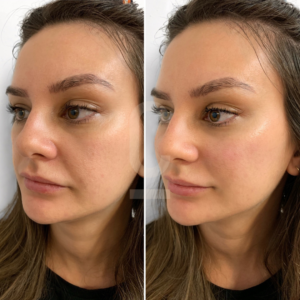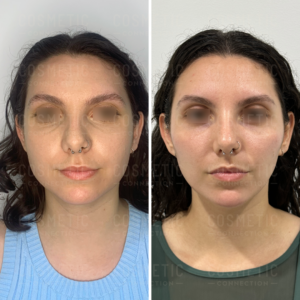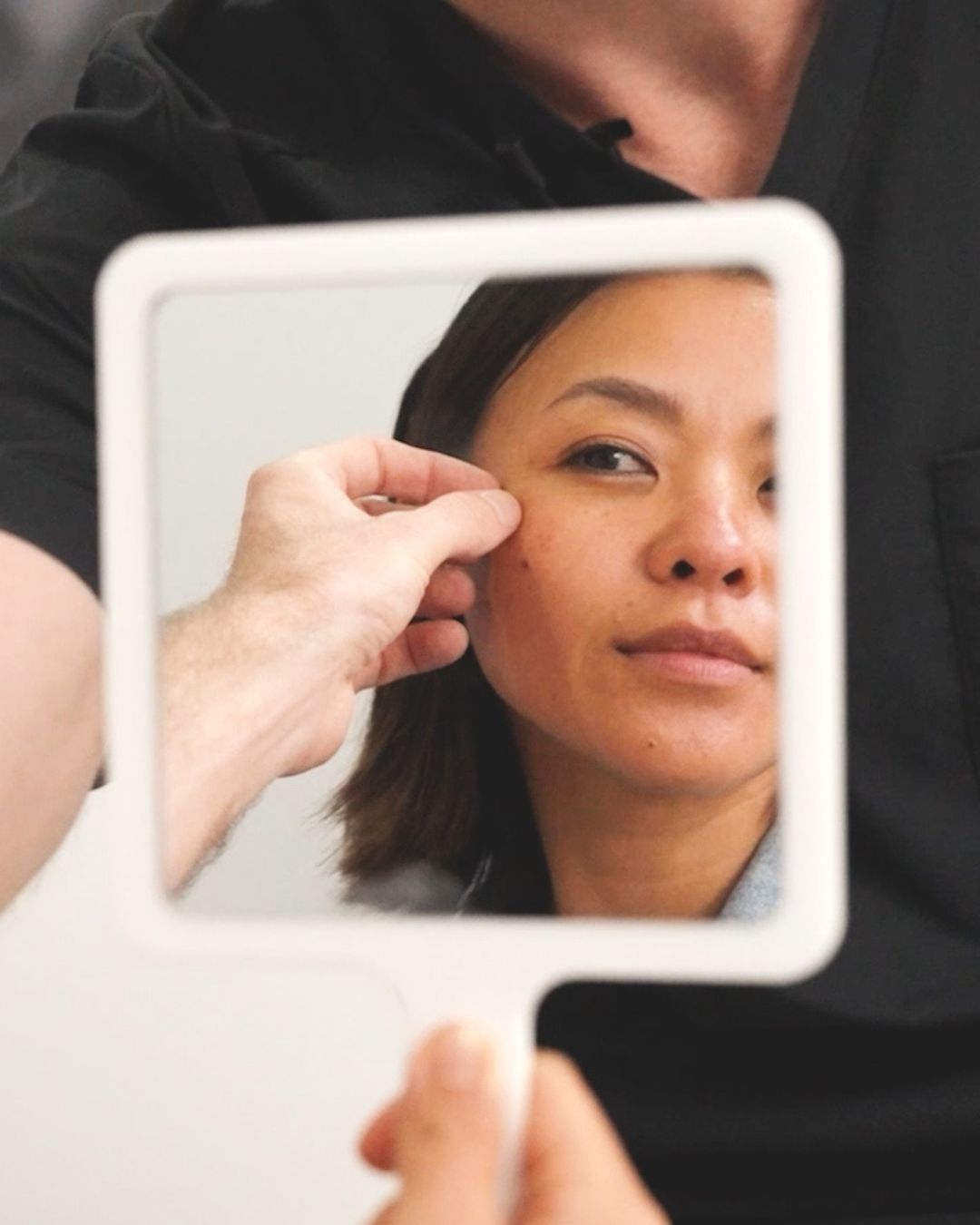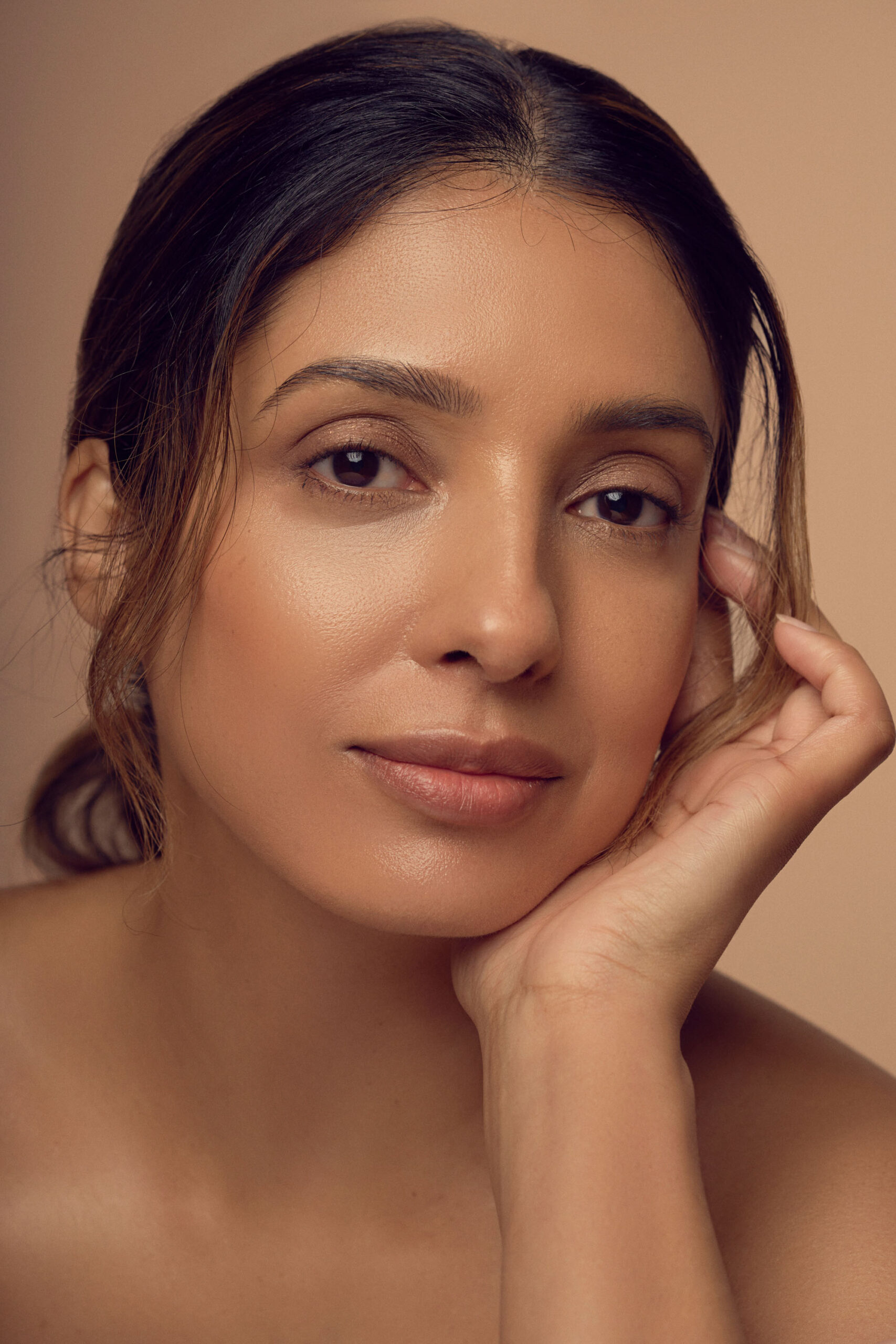Understanding Cheek Fillers
Cheek fillers are also known as ‘cheek dermal filler’, ‘cheek enhancement’, ‘cheek contouring’ and ‘cheek augmentation’.
What does cheek filler do for your face?
Cheek fillers enhance facial volume and structure, creating a more youthful and defined appearance. They can address sunken cheeks, nasolabial folds, and improve overall facial symmetry.
Are cheek fillers and cheek augmentation the same?
Cheek fillers are a type of cheek augmentation. Cheek augmentation can be done non-surgically with injectable fillers, or surgically with implants.
How do you know if you need cheek fillers?
Signs of needing cheek fillers include hollowness, nasolabial folds, sagging cheeks, and a tired appearance. These visible findings are typically seen when your cheeks lack volume.
Why should I get cheek fillers?
Cheek fillers are an effective way to both enhance your appearance, and treat signs of ageing like facial hollowness and sagging.
Many people choose to get cheek fillers because they are fast, convenient, effective, and precise.
Does 1ml cheek filler make a difference?
1mL cheek filler is a very conservative amount. While it will make a difference, for people with a moderate or severe lack of facial volume or structure, it is insufficient.
What does 1ml of cheek filler look like?
The results of 1ml of cheek filler varies depending on your natural facial structure. It will provide subtle results for people with a good baseline level of facial volume. For people who lack structure, 1mL of cheek filler will not make a noticeable difference.

Results from 1mL of cheek dermal fillers.
Do cheek fillers lift your face?
No, cheek fillers cannot lift your face. Unfortunately, the concept of using a cheek dermal fillers to lift sagging skin is incorrect. Even very reputable clinicians claim that adding volume to your cheeks creates a lifting effect. They promise improvements in sagging skin around your smile lines and jawline.
So, why do people claim the cosmetic injectables can lift?
If performed comprehensively, cosmetic injectables can give a more lifted look. However, this is because augmenting your cheeks gives your face more structure. It sculpts a more tapered face shape, which can be perceived as looking ‘lifted’, although no lifting has actually occurred.
If you want to look more lifted, cheek dermal fillers are a reasonable place to start. The first step towards a more lifted look is to comprehensively restore facial volume. Following this, collagen stimulation helps to make your skin stronger.
If you want to definitively lift moderate to severe sagging skin, surgery is required.
Does filler in cheeks lift jowls?
While cheek fillers can help improve facial structure, they do not lift jowls. To lift jowls, either thread lifting or surgery are required.
Do cheek fillers lift marionette lines?
No, cheek fillers do not lift marionette lines. To improve marionette lines, treatment with marionette line fillers or thread lifting are non-surgical options.
Do cheek fillers slim your face?
No, cheek fillers typically do not slim the face. However, they can sculpt a more tapered, V-shape face when used in combination with chin fillers and masseter injections.

A combination of cheek fillers, chin fillers, and slimming injections to the masseter jawline muscles.
Do cheek fillers change your smile?
Depending on the treatment technique, cheek fillers can be used to change your smile. They do this by adjusting the fullness of your cheeks. If you want cheek fillers without changing your smile, this is easy to accomplish. Just be sure to inform your cosmetic doctor of your preferences.
Do cheek fillers make you look chubby?
If too much filler is injected, it can create a puffy or unnatural appearance. However, when administered correctly, cheek fillers can enhance your facial features without making you look chubby.
What is a pillow face?
Pillow face is a term used to describe a swollen appearance of the face, often caused by excess fluid retention. Too much cheek filler can cause a pillow face by exacerbating facial fluid retention.
Does cheek filler look weird at first?
It’s common for cheek fillers to look slightly swollen or unnatural immediately after the procedure. However, these effects should subside within a few days as the swelling resolves.
Do cheek fillers look bigger at first?
Yes, cheek fillers may appear slightly larger at first, but they will gradually settle into a more natural-looking appearance. They look bigger because of local swelling, which takes a few days to resolve. Sometimes, filler can take 2-4 weeks to fully settle into position.
When do cheek fillers look their best?
Cheek fillers typically look their best within a few weeks after the procedure, as the swelling subsides and the filler integrates into the facial tissues.
Do cheek fillers look better after a few days?
Yes, cheek fillers often look better after a few days as the initial swelling subsides and the filler begins to settle.
Procedure and Pain
How painful are cheek fillers?
Cheek filler injections have only slight discomfort, often compared to a slight pinch. Topical numbing cream can be used to reduce pain, however this isn’t often required.
How do you sleep with cheek fillers?
It’s recommended to sleep on your back or side to avoid putting pressure on the treated areas, and to encourage swelling to settle. Do not sleep face down, as this can exacerbate swelling and move the cheek fillers.
Cost and Worth
Is it worth getting cheek fillers?
The decision to get cheek fillers is personal and depends on individual goals and preferences. However, many people find that the benefits, such as improved appearance and boosted confidence, outweigh the costs.
The benefits of cheek fillers include:
- Enhancing your cheeks with dermal fillers gives them more shape, definition and contour. The cheekbone can be highlighted, and the apex given more structure.
- A cheek augmentation with dermal fillers can support hollow under eyes, and restore volume lost with age or weight-loss. This will help you look refreshed and rested.
- Augmenting your cheeks and cheekbones with dermal fillers can improve the shape of your face. By adding structure to your cheeks, we can balance your mid-face, and achieve a square or tapered look, depending on your aesthetic preferences.
How much does 1 ml cheek filler cost?
The cost of cheek fillers can vary depending on the type of filler used, the amount needed, and the experience of the provider. However, 1ml of cheek filler typically costs between $800 and $1000. Beware cheaper clinics who often have untrained staff and use illegally imported products not approved by the TGA. There are also more reports of counterfeit products being used to save money in cheap clinics emerging.
How much is 1 syringe of cheek filler?
The cost of 1 syringe of cheek filler can vary depending on the type and brand of filler and the experience of the clinician. It’s essential to obtain a quote from your provider for accurate pricing. Typical costs will be $800-$1000 for a good clinic.
Are cheek fillers worth the money?
Whether cheek fillers are worth the money is a personal decision. To decide whether cheek fillers are worth it, consider the risks, longevity, and how much addressing your concerns will mean to you.
How much cheek filler is needed for the first time?
The amount of cheek filler needed for the first time can vary depending on individual facial structure and desired results. Your provider will assess your needs and recommend the appropriate amount. Most people have 2-3 syringes of cheek filler for their first treatment. Maintenance sessions are typically much more conservative, unless you wait a long time between sessions and allow most of the filler to wear off.
How much do cheek fillers cost in Australia?
The cost of cheek fillers in Australia can vary depending on the skill of the provider. However, you can expect to pay $800-$1000 per syringe of filler.
Age and Cheek Fillers
At what age should you get fillers?
There is no specific age for getting cheek fillers. However, they are often considered for individuals experiencing age-related facial volume loss, typically in their 30s and 40s. Younger people who lack naturally defined cheeks can also benefit from cheek fillers.
What is the best age to get cheek fillers?
The best age to get cheek fillers depends on individual factors and desired outcomes. However, many people find that the results are most noticeable in their 30s and 40s.
Do fillers work after 40?
Yes, fillers can be highly effective in addressing age-related facial volume loss, even after the age of 40. Cheek fillers are one of the foundation treatments for anti-ageing.
Risks and Side Effects
Who should not get cheek fillers?
Individuals with naturally full cheeks, or with unrealistic expectations about achieve results should not get cheek fillers. Those who are pregnant or breastfeeding are also not suitable.
Who is not a good candidate for cheek fillers?
Individuals with unrealistic expectations, allergies to fillers, or with naturally full faces are not good candidates for cheek fillers.
Is there a downside to fillers?
While cheek fillers are generally safe, there are potential risks and side effects, including swelling, bruising, and reactions. They also have limitations, and should only be used for appropriate indications such as facial volume loss, hollowness, and cheek contouring.
Can cheek fillers go wrong?
In rare cases, cheek fillers can go wrong, resulting in complications such as overcorrection, infections and reactions to the cheek fillers.
What are the side effects of cheek fillers?
Common side effects of cheek fillers include swelling, bruising, redness, and temporary discomfort.
Rare side effects include infections, reactions to the filler, and skin injury.
Are cheek fillers safe?
A cheek augmentation with dermal fillers is a low-risk procedure when performed by an experienced professional. It involves placing cosmetic injections into your cheeks to enhance volume, contour, and definition.
While side effects are rare, they include temporary swelling, redness, bruising, and discomfort. Very rare side effects include infection and skin injury. In the case of side effects, we can dissolve any cheek filler used for your augmentation.
To ensure your safety, choose an experienced professional at a reputable doctor-led cosmetic clinic. They will assess your suitability, discuss potential risks, and use proper injection techniques. You should also follow the aftercare instructions, and promptly report any concerns. This contributes to the safety of your cheek augmentation.
What happens if you don’t keep up with fillers?
Over time, the effects of cheek fillers will gradually fade as the body naturally absorbs the filler material. You appearance will return to normal, as though you never had cheek fillers. Keep in mind that if you’ve had cheek fillers for years, they will have disguised the ageing process. As the fillers wear off, you may look older than you remember, as the underlying ageing process is revealed.
Comparisons and Alternatives
Is Botox or fillers better for cheek augmentation?
Fillers are better for augmentation your cheeks. Botox relaxes facial muscles, and will not change the appearance of your cheeks.
What is better, cheek implants or fillers?
Cheek implants are a surgical option that can provide more permanent results compared to fillers. However, fillers are less invasive and no downtime. For convenience and flexibility cheek fillers are a better option. They also give you total control over your appearance in case your preferences change in the future.
Is a cheek lift better than fillers?
A cheek lift is a surgical procedure that can address sagging cheeks and improve facial contours. Cheek fillers are for hollowness and volume loss, and will not lift sagging. For a non-surgical cheek lift, a combination of cheek thread lifting and cheek fillers are more appropriate.
Duration and Maintenance
How long do fillers last in cheeks?
The duration of cheek fillers can vary depending on individual factors and the type of filler used. However, they typically wear off slowly over 1-2 years.
How long will 1ml of cheek filler last?
The duration of 1ml of cheek filler can vary, but it generally lasts for around 12-24 months. Higher volumes of cheek filler typically last longer, as it takes your body longer to break them down.
Do cheek fillers sag over time?
Cheek fillers do not sag over time. As you age, natural sagging can develop. Cheek fillers can mask this sagging, but don’t make it better or worse.
What happens when you stop getting cheek fillers?
Over time, the effects of cheek fillers will gradually fade, and your face will return to its natural appearance. As cheek fillers reduce signs of ageing, any age-related changes that have developed while you’ve had cheek fillers will emerge as they wear off.
Miscellaneous
How is a cheek augmentation with dermal fillers performed?
We usually enhance the shape and structure of your cheeks using dermal fillers. There are two techniques used to precisely place the fillers to augment your cheeks.
Needle technique
- Sharp needles are used to inject filler in precise locations. This adds precise support to key areas of your cheeks. Using a sharp needle is quick and can target very precise areas, however it comes with a slightly higher risk of bruising and swelling.
Blunt cannula
- We use blunt-tipped instruments known as cannulas to place filler over larger areas. They are ideal for restoring or enhancing general cheek structure. Prior to using the cannula, we create a small pilot hole in your skin with a tiny needle. We then carefully place the cannula beneath the skin through this entry point. Using a cannula reduces the risk of bruising and swelling. It also requires fewer injection points.
What if I don’t like my cheek filler?
If you are dissatisfied with the results of your cheek fillers, the best thing to do is contact the clinic who did them. They can see you for a follow-up to determine if your results can be improved. Otherwise, most cheek fillers are dissolvable, meaning they can be removed at any time.
What is the aftercare for cheek augmentation with fillers?
Aftercare for cheek fillers typically involves avoiding strenuous activity, excessive heat exposure, and touching the treated areas for a few days. You should also avoid makeup and alcohol for about 24 hours.
What happens to cheek filler if you lose weight?
Weight loss does not affect cheek fillers. However, losing weight can cause your face to look hollow as your facial fat reduces. In which case more cheek fillers may be needed to replenish volume and restore a fuller appearance.
What cheek fillers last 5 years?
Collagen stimulating fillers can last 5 years and longer in the cheeks. While traditional fillers are said to last 12-24 months, there is new evidence emerging that they can also last 5 years and longer, especially when done more than once.
Do cheek fillers make your face look younger?
Yes, cheek fillers can help create a more youthful appearance by restoring facial volume and reducing the appearance of hollowness and sagging.


